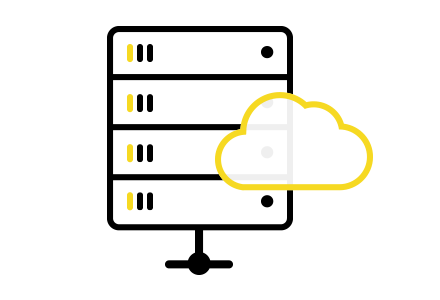| Ransomware Scanner | Price |
|---|---|
| Business asset analysis and report production | 63.50 € |
Protect your business with our anti-ransomware scanner to prevent economic losses and downtime caused by hacker attacks.
What is Ransomware?
Ransomware is one of the most dangerous malwares threatening the digital security of companies, and it is predicted that by 2031 the costs due to this cyber-attack may exceed 265 billion dollars. Therefore, it is essential to adopt preventive measures to protect your business.
It is a software designed to encrypt data, such as those on a server or on a website.
The hacker installs malware on your system to lock files, requesting a payment, usually in cryptocurrency. Subsequently, they will communicate the key to decrypt the data and return them to their original form.
In the event that the compensation requested by the attacker is not paid, the data would no longer be accessible and would be lost or, worse still, disclosed on the Internet.
This type of cyber-attack can have consequences on companies. The data shows that more than one incident out of four aims to extort money from the victims. Among other impacts: data theft (19%), credential collection (11%), data loss (11%) and brand reputation (9%).
The viruses of this type that have caused the most damage have been CryptoLocker and Wannacry.
How does the online Ransomware Scan work?
- Analysis request: open a ticket in your assistance area, indicating the server or the site you wish to protect.
- Professional analysis: our specialists will perform a vulnerability assessment to identify possible intrusion vectors.
- Detailed report: you will receive a complete report highlighting any vulnerabilities and recommendations on how to improve the security of your system.
- Continuous support: whether you are not vulnerable or need further assistance, our team is here to support you at every stage.

-
What is Ransomware?
Ransomware is a type of malware (malicious software) designed to encrypt files or block access to a computer or more generally to an IT system, then asking for a "ransom" in exchange for the key or information needed to restore access to the data. In other words, cyber criminals use Ransomware to hijack the victim's files and demand a money payment for returning access.
How does malware spread?
These types of viruses can infect a computer in several ways and depending on the tactics used by the creators of the malicious software.
The most common techniques through which ransomware can attack a computer system are:
- Phishing emails: there is a relationship between phishing and ransomware. Hackers send emails containing malicious attachments or links to infected websites. When the victim opens the attachment or clicks on the link, the ransomware installs on the computer.
- Downloads from compromised websites: compromised websites can be an intrusion vector and used to download and install ransomware on the user's computer without their consent.
- Software vulnerabilities: the most widespread method, which leverages vulnerabilities present in system software or services exposed to the Internet. Users who have not installed the latest security updates are particularly vulnerable.
- Distribution through peer-to-peer (P2P) or torrent networks: some users illegally download software, games, or media from unofficial sources through P2P or torrent networks. These files can be modified to include malicious software.
- Instant messaging and social engineering: attackers can exploit instant messaging services or social media to send malicious links or convince people to download and open malicious files.
- Infected USB drives or removable devices: in some cases, ransomware can spread by connecting infected USB devices to a computer. Once the infected device is connected, the virus spreads to the system.
- Other malware: some cryptovirus can be distributed and installed by other harmful programs already present on a computer.
What happens to a pc hit by Ransomware?
Here are the 4 most common phases that describe how this type of cyber threat is launched:
- Infection: the malware enters the victim's system.
- Data encryption: at this point the ransomware encrypts the victim's files, making them inaccessible.
- Ransom demand: following the infection, victims receive a notification on the screen or a text file explaining how to pay the ransom. Cyber criminals often request payment in cryptocurrency (such as Bitcoin or Monero) and promise to provide a decryption key or a method to restore the files.
- Extortion: if the victim decides to pay the ransom, the criminals may or may not provide the means to decrypt the files. In many cases, criminals may demand additional payments or not honor agreements, making data recovery uncertain.
It is important to emphasize that paying the ransom is not guaranteed and is not encouraged, as it feeds the criminal business model of ransomware creators. Moreover, paying cyber criminals does not guarantee that the data will actually be restored and may also make the victim a future target.
In which dimension does Ransomware act?
Ransomware attacks can affect a wide range of individuals and organizations. Some groups are particularly at risk, but in general anyone using a computer or a device connected to the Internet can be vulnerable. These categories of people and organizations that may be particularly at risk:
- Small and Medium Enterprises: lthey may be targeted because they often have limited resources to invest in high-level cybersecurity. However, they may have valuable data that cyber criminals want to encrypt and demand a ransom for.
- Government agencies: government agencies at local, national, or international level may be likely targets, as they manage sensitive information and critical services.
- Hospitals and medical facilities: hospitals and medical facilities are often targets of ransomware attacks because they contain sensitive medical data and data availability is essential for patients' lives.
- Educational institutions: schools, universities and other educational institutions may be vulnerable as they contain data on students and staff, in addition to operating with limited budgets for cybersecurity.
- Key infrastructure sectors: critical infrastructures such as energy, transport, and utilities may be targeted as their disruption could have serious consequences.
- Private citizens: even home users are not immune to ransomware attacks, especially if they use devices connected to the Internet.
- Industry sectors: some sectors, like manufacturing or financial industry, can be targeted depending on the value of the data and the ability to pay the ransom.
In general, no one is completely safe, so it is crucial that anyone using computers and devices connected to the Internet take precautions to protect their data and systems.
Why are Ransomware effective?
Ransomware are effective for several reasons:
- Strong encryption: the encryption used by Ransomware is often very strong and almost impossible to decrypt without the correct decryption key. This means that once the files have been encrypted, it becomes extremely difficult or impossible to recover them without paying the ransom.
- Ease of distribution: malicious applications can be distributed relatively easily through various means, consequently hackers can reach a wide audience and infect numerous systems in a short time.
- Anonymous ransom demands: lransom demands are generally made in cryptocurrency, which offers a certain degree of anonymity to attackers. This makes it more difficult for authorities to identify and prosecute them.
- Panic and psychological pressure: victims of ransomware attacks often experience panic and psychological pressure, as they see their data locked and fear permanent loss of valuable information. This can push some victims to pay the ransom in order to restore access to their data.
- Diversified targets: malicious software can target a wide range of targets, from companies to government institutions, to home users.
- Understanding human weaknesses: attackers often exploit human weakness through tactics such as phishing and social engineering to convince people to click on links or open malicious attachments.
How can I protect myself from Ransomware: the solutions
Protecting oneself from ransomware requires the adoption of various good cybersecurity practices. To reduce the risk of being a victim of a ransomware attack, it is necessary to:
- Regularly update software: always keep the operating system, programs, and applications exposed to the Internet updated.
- Antivirus and anti-malware software: use reliable antivirus and anti-malware software and make sure to perform scans regularly.
- Data backup: regularly back up important and sensitive data to external devices or secure cloud storage services. Having data backups allows you to restore business operations or normal activity more quickly, reducing downtime and limiting financial losses.
- Cybersecurity education: educate yourself and your team or organization members on cybersecurity.
- Email filtering: use anti-phishing filters and anti-spam services to reduce the chances of receiving malicious emails.
- Remote desktop protection: if you use Remote Desktop to access your server, make sure connections and computer access protocols are protected with strong passwords and protected with VPN or Firewall services.
- Access with minimal privileges: limit administrative access only to people who need it. Accounts with high privileges are often primary targets for attacks.
- Password management: use strong passwords and change them regularly. Consider using a password manager to create and store complex passwords securely.
- Web content filtering software: use web content filtering software to block access to harmful or suspicious websites.
- Incident response planning: prepare an incident response plan that defines the actions to be taken in case of a ransomware infection. This plan should include recovery from backups and notification to authorities if necessary.
- Keep an offline copy of important data: keep an offline copy of the most critical data, so that they are not accessible online and therefore safe from ransomware attacks.
Encrypted files: how to recover them
The possibility of decrypting files encrypted by a ransomware without paying the ransom depends on various factors, including the specific type of virus used and therefore the encryption model employed.
Here are some options to consider for managing a potential threat:
- Data backup: if you have backed up your data before the attack, you can restore the encrypted files from your copies.
- Ransomware decryptor: in some cases, cybersecurity companies and government agencies have developed free decryption tools for known ransomware. You can search online to see if there is a decryption tool for the specific type of ransomware that hit your system. However, this option is limited to known variants of ransomware and the margin of success is almost nil.
- Assistance from law enforcement: in some cases, the competent authorities and security agencies may be able to provide assistance for data recovery from a ransomware attack. This option may take time and may not be available in all cases.
What should I do if the system has been hit by Ransomware?
If your computer has been infected, it is important to act promptly to mitigate the damage and try to restore your data.
Here is a series of steps to follow if you find yourself in this situation:
- Isolation: isolate the infected computer from the network. Disconnect it from the Internet and from the business or home network to prevent the ransomware from spreading to other devices.
- Backup encrypted data: before attempting any operation, back up the encrypted files so that you can keep them in case there are future developments in decryption.
- Ransomware removal: use antivirus or anti-malware to scan the system.
- Identify the Ransomware: try to identify specific type of ransomware that hit your system. This can help you determine if there are decryption tools available for that variant.
- Restore files from a backup: if you have backup of uninfected data, you can restore your files from there.
- System restore: some ransomware may alter the operating system. In this case, you may need to restore the operating system to a state prior to the attack. This may require the use of system restore features or reinstalling the operating system from scratch.
- Report the attack to the authorities: in some cases, it may be appropriate to report the ransomware attack to competent authorities, such as cyber police.
- Do not pay the ransom: avoid paying the ransom demanded by cyber criminals. There is no guarantee that you will receive the decryption key, and payment may encourage further attacks.
What are the most common types of Ransomware?
Since new variants appear every day, it is not simple to define what Ransomware is and which is the most common.
However, we can list several examples, such as Petya, which encrypts the entire hard disk, CryptXXX, still very active and dangerous
TeslaCrypt was the most widespread Ransomware in the first four months of 2016, while WannaCry, which debuted in the first days of May 2017, together with CryptoLocker has been so far one of the most dangerous Ransomware.
And if I need a check for other types of hacker attacks?
Understanding and addressing different cyber threats is essential to maintain a secure and resilient digital environment. Our vulnerability assessment service is not limited only to checking the risks associated with Ransomware, but performs a comprehensive security assessment that identifies potential vulnerabilities and provides you with a detailed overview of the threats to which your IT infrastructure may be exposed. This includes a variety of hacker attacks such as phishing, SQL injection, DDoS attacks, and many others.



